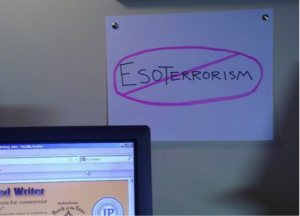I landed a new commercial writing client some time back – a graphic designer a few states away who’d found me via the web. His freelance copywriter had walked out the prior week and he was stuck with some looming deadlines – one just 24 hours away.
When I gave him a quote (with a 20% additional rush charge) for the hot job – two concepts for a direct mail postcard (front-side headline and reverse-side sub-head and body copy), it was obviously more than he’d hoped for.
He started thinking out loud on the phone, finally concluding that, with 24 hours till showtime, he was nervous about entrusting the project to an unproven (to him) commercial copywriter, and risking his deadline with a good client.
His solution: he’d concept the headline and I’d do the back cover copy. I’d start on my part and could adjust the tone to fit the concept he’d send me the following morning. Fair enough.
After we got off the phone, my mind just started working on the uncontracted headline portion. Not wise, but I couldn’t help myself. This kind of work is like a game to me – BIG fun. I spent no more than 30 minutes at it, but came up with a few pretty good ideas.
A few minutes later, he called about something else, and at the end of the call, I explained what I’d done, adding, “If you decide to use one of them, technically, you don’t owe me anything, but rather than be stingy, I’ll share and let the chips fall where they may.â€
Well, turns out he loved one of them saying, “I know a good headline when I see one,†and then asking, “If I were to use it, what would you charge? I don’t believe in people working for free.†Do you love this guy or what?
My reply: “You already know what I’d normally get (important to establish your regular rates if you ARE going to take this approach), but in this case, if you want to throw me an extra $100-150, I’m happy.†Him: “I’ll absolutely pay you $150.â€
Okay, so what that I didn’t get my usual commercial freelancing rate? I wasn’t going to anyway on this job. I got $150 extra for 30 minutes work and came up with a great headline that allowed him to spend his evening with his family, not holed up in his study, concepting headlines.
I made a great first impression, establishing myself as a talented and generous writer who thinks like he does, and can come through in the clutch.
Some may say, “Tsk. Tsk. You set a bad precedent.†I disagree. He acknowledged that a headline would normally be worth far more, and in the future, we’ll come to a number that’ll work for both of us, (or, I suppose, we won’t). Either way I’m not concerned.
I’m not suggesting you always play the “give-it-away-for-peanuts†game; in this case, it just made sense to do it. I AM suggesting that, as long as the client knows what your normal rates are, you come from a place of generosity and abundance.
And by coming through on no notice, he starts seeing why I charge what I do. I gave a little, got a fair return, ended up looking really good in his eyes, and nicely set the stage and his expectations (both work- and money-wise) for future work. Win-win.
As I see it, as commercial freelancers, we need to strike a balance between expecting to be paid well for our skills, and having a little elasticity in that policy. Certainly, if you could only be one way or the other, the former is clearly better than the latter.
Too much of the latter isn’t good for building respect on the part of your clients, nor cultivating the internal variety. But, if you do too much of the first, taking, say, a “I-don’t-pick-up-a-pen-for-less-than-$500†approach, being a commercial freelancer becomes largely a clinical and left-brain exercise.
Allow yourself to have your moments of spontaneous, unscripted generosity, minus the fee minimums and clock-watching. They’ll make doing this job of ours more fun and joyful, you’ll build stronger, more enduring relationships, and (as I was able to do here), they can clearly convey why you deserve to be well paid.
Have you had a similar scenario?
If so, how did it unfold and where did it lead?
Do you watch the clock closely or are you less manic about time?
Where have you drawn that line between running a serious business and having a little flexibility in your time policy?
(NOTE: I was serious about loving the short-copy stuff: taglines, company/product naming, headlines, book titles, etc. If you run across such work, and it’s not your thing, think of me (and I’m happy to pay a finder’s fee). Samples here, then “Naming/Taglines & Slogans…†And here for book titles…).
Want to be a guest blogger on TWFW Blog? I welcome your contribution to the Well-Fed writing community! Check out the guidelines here.


